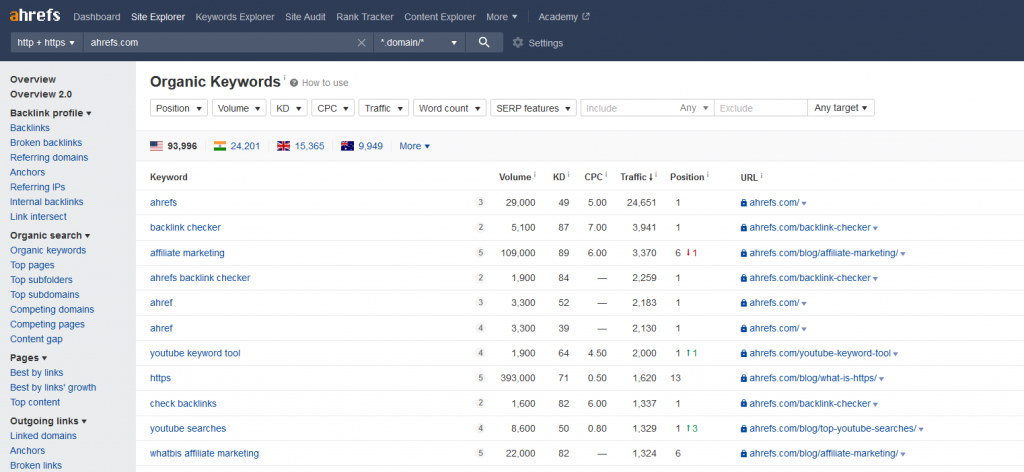25 Mar

SEO optimization of the online store
What does SEO optimization of an online store look like?
Investing in SEO optimization of an online store is now practically mandatory. Thanks to it, you can effectively reduce the costs spent on advertising. This type of optimization is slightly different from “traditional” optimization. I mean here the practices used in e-commerce, e.g. appropriate schemes for image attributes, aspects used in filters, etc.
When approaching the topic of on-site SEO optimization of an online store, three main aspects should be taken into account:
● Content optimization
● Technical optimization
● Conversion rate optimization
Table of Contents
Optimizing the content in the online store
Keyword analysis

The first, main aspect that should be done before undertaking on-site activities is performing a thorough keyword analysis. A thorough analysis separating groups of words into transactional, blog, generic, brand keywords, etc., will significantly facilitate (and even enable) the creation of an appropriate website structure. Appropriate subpages will be assigned to the groups of keywords, and on them will be implemented properly optimized content based on the keywords assigned to the group.
For more on keywords, see the article: Keywords – TOP 6 keyword research tools
Create titles and meta descriptions
Having created an analysis, a very important aspect is to create, above all, correctly optimized titles, as well as meta descriptions that have a direct impact on the click-through rate from the search results.
When creating a title, you should use the most relevant keywords, including the most searched ones at the beginning of the title (if only these types of keywords in a specific case will be the most appropriate).
I wrote more about creating titles and meta descriptions in the article – SEO Audit
Optimization of headers and their structure

The structure of the headers should be preserved, but the most important thing is to include keywords in them, which are an important aspect in the case of SEO optimization of the store. You can also read a little more about this aspect in the article linked above.
Create category descriptions
The categories should contain content that will contain the keywords designated from a specific group in the keyword analysis. In order not to lower the conversion, a good option is not to implement the entire description just below the header (above the product listing), but to divide it in such a way that when you open the category, you can see the products from the listing at a glance (without the need to use the slider).
Usually 1-2 paragraphs depending on their size above the listing, and the rest of the text below the products. It is good if the most important keywords are included in the paragraphs above the listing to allow search engine crawlers to render them before rendering the rest of the content and other aspects (theoretically, SEO specialists’ opinions are quite divided on this issue, although sometimes they test this issue and in my opinion it is better for now using this very way of implementing content).
Creation of product descriptions
Usually, in online stores, categories are optimized, although after 1 – not always, and after 2 – it does not mean that product descriptions should be duplicated, without quality or taken from the manufacturer. Uniqueness and attractiveness are the aspects that make users more likely to buy a given product.
When optimizing categories, product descriptions should include keywords that are only a reinforcement in the Topical Authority algorithm (in an appropriate way so as not to cause potential cannibalization), although the most detailed presentation of the product is a very important aspect. The user should find out everything about the product without the need to ask any questions.
The description should also include phrases (CTA) that will encourage the potential customer to make a purchase.
Technical optimization of the online store
Online store analysis and audit
If we are starting work on an existing online store, it is a good idea before starting on-site activities to create an SEO audit to know what technical aspects are important to implement.
It is worth checking the items I mentioned in the SEO audit article for a detailed look at most of the technical aspects that affect organic results.

Navigation in the online store
In the case of e-commerce, a very important element is the correct structure of the menu structure. It should not contain the full directory tree, because that way we would lower the values of individual pages by spreading the internal PageRank into internal links. It is necessary to skillfully manage the flow of internal linking so that for Google the most important are those subpages that are also the most important for us.
In addition to the menu, it is important to place appropriate user guidance in the form of intuitive pagination or presentation of products in a favorable way for conversion (e.g. including adding buttons to the cart in the right places, additionally taking care to distinguish them from the rest).
Internal linking of the online store
Aspect briefly mentioned above, although this is a much more advanced issue. In the article linked above, I mentioned it a bit more, but if I were to define the main purpose of internal linking in online stores, it would be: strengthening the most important subpages.
A good practice that is often used is, for example, linking within themed silos. If we want to solve an aspect in 5 minutes, automatically (in the end, it will probably be better to manually choose words in a more unique way), we can solve it as follows:
We have category X
The category includes subcategories:
● Sub-category 1
● Sub-category 2
● Sub-category 3
In an automatic way, you can use, for example, a script in PHP, which will implement a string like: “Also check products from the category: Subcategory 2” on subcategories (subcategories would be automatically downloaded from a given category). The keyword “Subcategory 2” would link to this subcategory.
Subcategory 2 would link to 3 and 3 to 1, completing the linking circle.
Additionally, each subcategory would also link to a category X subpage.
It should be remembered that the more internal links, the slightly lower the value of a given subpage. Personally, I use a minimal amount of them (note that I have linked the SEO audit article only 1 time and mention it quite often).
Another important aspect in directing the internal linking flow is the elimination of “a” elements from unnecessary aspects that the Google crawler should not go through (eg, filters that we do not want to index, “Add to Favorites” etc.). This is how we optimize Crawl Budget and make sure that subpages do not decrease their value due to countless internal links.
Store structure
This aspect is related to the above regarding the menu and internal linking, but I decided to break it down into a separate section to pay attention to the appropriate selection of products for the category and skillful management of them. Sometimes it is worth considering whether, having 5 categories with different “values”, it is worth putting all 5 in the menu, or for example 3, and the other 2 would be available after the next transition.
For example: A category does not have to include all subcategories in a submenu, and for example they could only be available after switching to a given category. In this way, we will direct a greater value of internal PageRank to a given category, thus strengthening its situation in internal linking – it should be considered individually for a given situation.
Which e-commerce platform to choose?
Personally, I recommend the most platforms that allow you to interfere with as many files as possible (preferably all). Therefore, I am not a supporter of any platforms in which we can set up the store through the browser in a few clicks, because we will probably not be able to access all files in such situations. I do not want to mention these types of websites by name, although most of them work on a similar principle.
However, I recommend platforms such as Magento or Prestashop. Depending on the size of the store and the number of products, both of these systems give the possibility of interfering with the files, so we can do whatever we need. In “browser” platforms, many things we cannot do ourselves, and some cannot be done at all (even after sending implementation guidelines to the support).
How to encourage a customer to buy?
In addition to the appropriate UX and UI, it is worth encouraging a potential customer with slightly more psychological methods, e.g.
● using social proof of rightness in the form of reviews, opinions, “stars” etc.
● using the principle of contrast
● writing in the language of benefits
● applying the principle of unavailability (limited-time offer, etc.)
How to encourage the customer to return to the store?
There are quite a few ways, for example:
● use of vouchers
● mailing (if we have access to users’ e-mails)
● remarketing
● attractive products at competitive prices
● good opinions not only about the products, but also about our brand
● very good service (access to chat, telephone contact options, quick response to inquiries etc.)
Building popularity and image
All activities contribute to building the image of our company. Its good image will also have a positive impact on the conversion, because we will become a credible and reliable company in the eyes of a potential customer, and on such websites the user will probably be more willing to make a purchase.
The most common mistakes in online stores
Below is a short list of the most common mistakes when creating online stores:
● Unattractive presentation of products
● No correctly implemented mobile version
● Incomplete information about the seller and unintuitive contact options
● Frequently asked questions (FAQ) are not answered
● Unintuitive and tedious purchasing process
● No trust-building elements (user reviews, number of items purchased, product ratings, information on delivery, returns, etc.)
● There is no SSL certificate
● Intuitive information about the delivery and the lack of its various forms
● Mismatched graphic template (unfriendly, not very useful and non-functional website with mismatched graphic design that creates purchasing barriers – no UX care, etc.)
● Poorly designed menu, unreadable division or complicated navigation, making it difficult to find a product
SEO expert with over 10 years of experience in the industry. He has worked for many international companies known globally, creator of the Boostsite.com algorithms.
Leave a Comment
SEO expert with over 10 years of experience in the industry. He has worked for many international companies known globally, creator of the Boostsite.com algorithms.


Marcin Gaworski